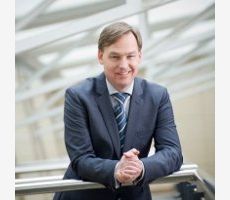
SwedeCenter entered the Polish market in the 1990s. Have you noticed any changes in Poland’s construction industry over the last 20 years of your experience in the market?
In my opinion, the most noticeable changes occurred in what we offer to our tenants. The profile of our investments has changed and we have been paying more attention to the environment and the comfort of working environment. Tenants easily notice differences in standards of buildings and select those that offer something more than just working space. The best example is the innovative concept of business parks – Business Garden, developed by SwedeCenter.
You have been locating your buildings in Poland’s largest cities. Do you conduct any research concerning location? (Where and why they are the best?)
We have been investing mostly in large agglomerations; however, we do not rule out investments in smaller cities in Poland. Everything is up to the location which is always subject to appraisal by our team. As a standard, we check all possible conditions and requirements; we estimate costs and look at possibilities of site development so that the best functions can be proposed for each site.
Since when and why have you focused on constructing sustainable buildings? (Is it just to support ecology or is it what the market requires?)
Our interest in sustainable construction does not stem from the fashion for green buildings but is a result of a long-term business philosophy. Please note that SwedeCenter does not sell its projects rights after completion. They stay in our portfolio for a number of years. It is important that they remain attractive over a longer period of time. This is possible only in case of well designed and constructed buildings or such where the applied solutions will meet the expectations not only of the current tenants and also those that will come later.
Have you performed market research to identify the scale of demand for “green buildings”?
During over 20 years of investment and development operations in the Polish market we have gained know-how to identify the relationship between market demand and supply on the part of owners. In our opinion, such type of construction soon will no longer be extravagant but a starting point in planning most of new investments.
Do tenants often ask for certificates? What is the proportion of tenants who are really interested in sustainable construction?
An increasing number of tenants ask if the building is provided with ecological solutions but only very few are really interested in having confirmation that LEED-compliant solutions have been implemented. So far only on two occasions we had to submit full documentation in that context.
Is the fact that a building has been certified a guarantee of an increased rent?
There is common conviction that LEED-certified offices have somewhat higher rent. In case of space offered by SwedeCenter in its buildings, the fact that they are certified in no way affects the rent level.
What kind of savings are associated with operating a certified building? (For example, what kind of savings are generated by a company employing 100 people?)
According to general analyses, in “green buildings” savings in energy consumption reach 25-30%, in water consumption about 30%. This is translated into reduced operational costs incurred by tenants. No less important is the fact that “green” buildings offer better ventilation, temperature control. Lighting and reduced level of air pollution. That in fact has a positive impact on work productivity and better feeling by employees.
What is the increase of investment costs for office buildings that apply for a LEED certificate as compared to a building that does not apply to be certified?
Building certification does not have to generate additional costs. Until a certain level of certification, the construction costs do not differ with standard solutions. This is our case. It is also important that we work with LEED consultants from the very beginning of the investment and we are able to implement ecological solutions from the stage of designing so that they become an integral part of the development process.
Do you plan any more projects for the near future? (Apart from the three that are officially planned by you). If so, do you already know the location?
Now we plan projects in Warsaw, Szczecin and Sopot. Totally that will be 74 000 square metres of office space and hotels. We also plan to construct another 650 000 square metres of office, residential and hotel space in Poland’s largest cities - Warsaw, Gdynia, Poznań and Wrocław. Such large projects do not restrict us in looking for new investment opportunities.